Published: 22 June 2021
Municipal elections 2021, result of the control calculation
The National Coalition Party became the biggest party in the Municipal elections with 21.4 per cent of all votes cast, which is 3.6 percentage points higher than the Social Democratic Party’s share of votes and 6.5 percentage points higher than the Centre Party's share. The Finns Party increased its support most, by 5.6 percentage points. The voting turnout was lowest since the 1945 elections, as 55.1 per cent of persons entitled to vote cast their vote. Detailed election results can be found in Statistics Finland's PX-Web database service.
Support for parties in Municipal elections 2012, 2017 and 2021, %
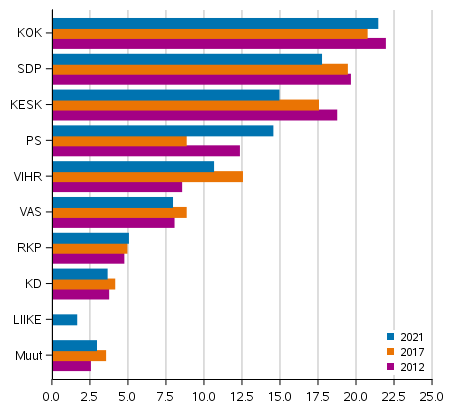
In addition to the Finns Party, support increased for the Coalition Party (0.7 percentage points) and the Swedish People’s Party (0.1 percentage points) compared with the previous Municipal elections. The other parliamentary parties that participated in the previous Municipal elections lost their support. In relative terms, the Centre Party lost most votes, as its share of votes cast was 2.7 percentage points lower than in the previous elections. Support for the Green League fell by 1.9 percentage points, for the Social Democratic Party by 1.6 percentage points, for the Left Alliance by 0.9 percentage points and for the Christian Democrats by 0.5 percentage points from the previous Municipal elections. The Movement Now party participating in its first Municipal elections received 1.6 per cent of all votes cast.
Parties outside the parliament and constituency associations gained 2.9 per cent of all votes cast. Altogether 292 municipal councillors were elected from constituency associations’ lists in the whole country, of the parties outside the parliament only the Blue Reform gained a total of four councillors to new councils.
Support for parties in Municipal elections 1953–2021, %
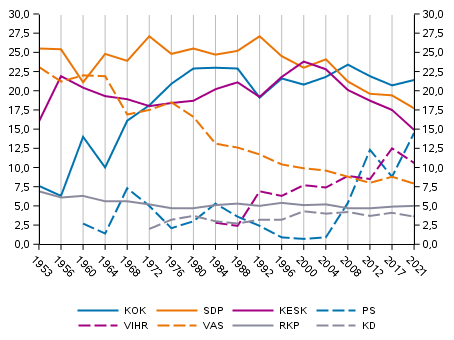
Current parties and their predecessors
Voting turnout fell from the previous Municipal elections
The voting percentage in the Municipal elections was lowest since the 1945 elections, 55.1 per cent. The voting percentage went down by 3.8 percentage points from the previous Municipal elections. Examined by constituency, voting turnout was highest in the constituency of Helsinki (61.7 per cent) and lowest in Savo-Karelia (50.2 per cent). Examined by municipality, the voting turnout was highest in Utsjoki (81.6 per cent) and lowest in Pieksämäki (46.5 per cent).
Voting turnout in Municipal elections 1945–2021, %
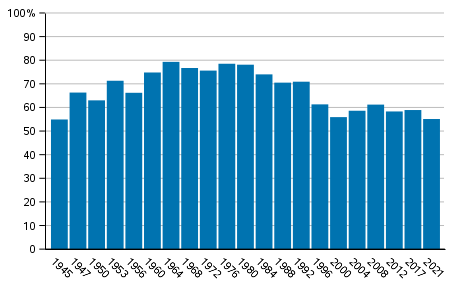
Women voted in the elections more actively than men, women’s voting percentage was 56.5, or 2.9 percentage points higher than men’s voting percentage. Women have voted more actively than men in the Municipal elections since the 1984 elections. The popularity of advance voting grew significantly in the 2021 elections. As many as 60.0 per cent of all who voted cast their votes in advance.
Table 1. Turnout by sex in Municipal elections 1921-2021 (%)
| Year | Total | Men | Women | Advance voters |
| 2021 | 55,1 | 53,6 | 56,5 | 60,0 |
| 2017 | 58,9 | 56,9 | 60,7 | 45,2 |
| 2012 | 58,3 | 56,7 | 59,8 | 42,4 |
| 2008 | 61,2 | 59,3 | 63,0 | 39,9 |
| 2004 | 58,6 | 56,4 | 60,7 | 39,1 |
| 2000 | 55,9 | 53,9 | 57,7 | 37,7 |
| 1996 | 61,3 | 59,8 | 62,8 | 34,9 |
| 1992 | 70,9 | 69,6 | 72,1 | 38,1 |
| 1988 | 70,5 | 69,0 | 71,9 | 18,3 |
| 1984 | 74,0 | 73,7 | 74,3 | 9,2 |
| 1980 | 78,1 | 78,2 | 78,0 | 8,0 |
| 1976 | 78,5 | 78,6 | 78,5 | 6,8 |
| 1972 | 75,6 | 75,8 | 75,4 | 5,3 |
| 1968 | 76,7 | 78,4 | 75,3 | - |
| 1964 | 79,3 | 80,9 | 77,9 | - |
| 1960 | 74,8 | 77,4 | 72,7 | - |
| 1956 | 66,2 | 70,0 | 62,9 | - |
| 1953 | 71,3 | 75,3 | 68,0 | - |
| 1950 | 63,0 | 67,6 | 58,9 | - |
| 1947 | 66,3 | 69,9 | 63,2 | - |
| 1945 | 54,9 | 57,9 | 50,9 | - |
| 1936 | 48,0 | 52,3 | 44,4 | - |
| 1933 | 45,5 | 50,0 | 41,8 | - |
| 1930 | 42,2 | 47,2 | 37,9 | - |
| 1928 | 42,5 | 46,9 | 38,7 | - |
| 1925 | 38,3 | 42,5 | 34,6 | - |
| 1924 | 27,8 | 31,6 | 24,4 | - |
| 1923 | 29,7 | 33,4 | 26,5 | - |
| 1922 | 32,3 | 36,6 | 28,6 | - |
| 1921 | 36,1 | 40,4 | 32,2 | - |
Party analysis
The party analysis examines the parties’ results in the Municipal elections 2021 with the help of various background variables in classified areas. Changes in the parties’ support are examined relative to the result of the previous Municipal elections. The voting districts whose borders have changed as little as possible since the previous elections are used as the data. Small voting districts with fewer than 1,000 persons entitled to vote are combined so that the average size of a voting district is about 2,000 persons entitled to vote. The analysis is based on around 1,450 areas comparable to the previous elections. The analysis presents party-specific data on such parties whose results can be compared with the previous elections.
The background variables used in the analysis are the area’s economic structure, degree of urbanisation, income level, unemployment rate and the number of pensioners. The background variables used are not mutually exclusive. For example, the area’s industrial structure and degree of urbanisation also partially describe the area’s income level. (See the methodological description.)
Support for the Coalition Party and the Green League was highest in areas where the share of pensioners in the population is low. By contrast, support for the Centre Party was clearly focused on areas with a large share of pensioners. Support for the Social Democratic Party and the Finns Party was more even in areas specified by the number of pensioners, however, focusing slightly on areas where the number of pensioners is average or above average. In relative terms, both the Centre Party and the Social Democratic Party lost most votes in areas with a large share of pensioners, while support for the Green League decreased most in areas where there were fewer pensioners than average. The Finns Party increased its support fairly evenly in areas specified by the number of pensioners, while no significant changes took place in support for the Coalition Party.
Support for the parties in the Municipal elections 2021 by the number of pensioners in specific geographical regions, %
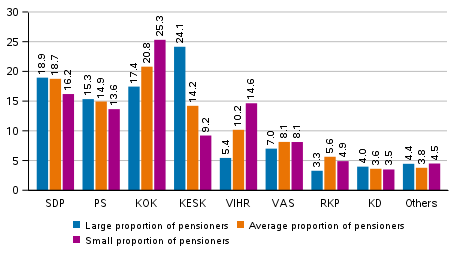
Change in the support for the parties in the Municipal elections 2021 by the number of pensioners in specific geographical regions, %
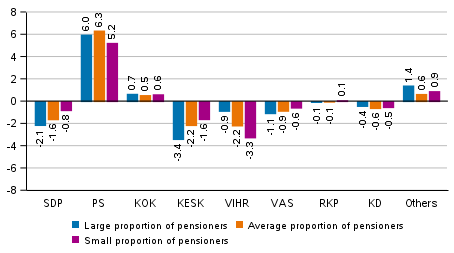
Support for the Coalition Party, the Green League and the Left Alliance was highest in densely populated urban areas. Support for the Social Democratic Party was highest in population centres and for the Centre Party quite clearly in sparsely populated areas. Support for the Finns Party was also focused on sparsely populated areas and population centres, even though the party’s differences in support were relatively small in areas specified by population density.
The Finns Party increased its support especially in sparsely populated areas and population centres, but to a lesser extent also in towns. Support for the Centre Party decreased most in sparsely populated areas, for the Social Democratic Party in semi-urban areas and in sparsely populated areas. The Green League lost its support especially in towns.
Support for the parties in the Municipal elections 2021 by areas specified by population density, %
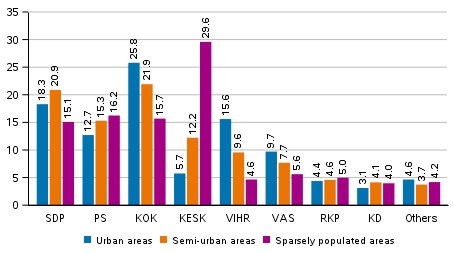
Change in the support for the parties in the Municipal elections 2021 by areas specified by population density, %
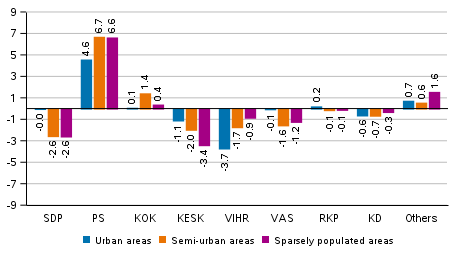
The Coalition Party and the Swedish People’s Party won the biggest support in areas where the average number of unemployed persons was lower than average. By contrast, the support profile of the Social Democratic Party and the Left Alliance was opposite in this respect, as the parties gained most support in areas with higher than average unemployment. The differences in support for the Finns Party and the Green League in areas specified by the employment rate were not large, while support for the Finns Party focused on areas with slightly higher unemployment and for the Green League on areas with lower unemployment. The parties that lost their support in the elections, the Social Democratic Party, the Centre Party and the Green League lost support quite evenly in all areas specified by the unemployment rate. Support for the Finns Party rose in all areas specified by the employment rate, focusing on the areas with slightly higher than average unemployment.
Support for the parties in the Municipal elections 2021 by areas specified by the unemployment rate, %
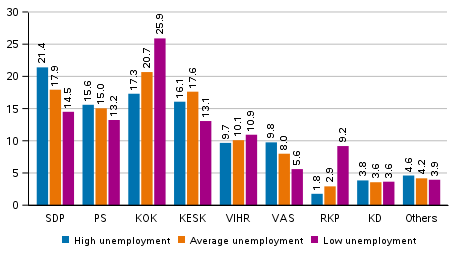
Change in the support for the parties in the Municipal elections 2021 by areas specified by the unemployment rate, %
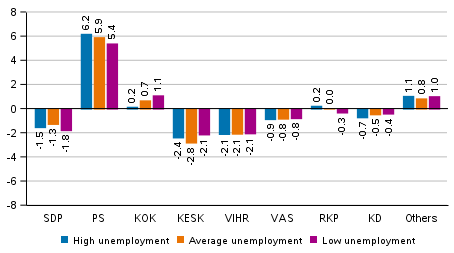
The Coalition Party and the Green League gained the biggest support in areas where the income level of those living is higher than average. In contrast, support for the Centre Party was highest in areas with low income levels, which is explained by lower income levels than average in agriculture-dominated and sparsely-populated areas. Support for the Social Democratic Party was highest in areas with average income levels and for the Left Alliance in areas with low income levels, and for the Finns Party support was divided fairly evenly between areas with different income levels. Support for the Centre Party’s fell particularly in areas with low income level, for the Green League in high income level areas and for the Social Democratic Party quite evenly in all areas specified by the income level. Support for the Finns Party increased in all areas, most in areas with average income level.
Support for the parties in the Municipal elections 2021 by areas specified by the income level, %
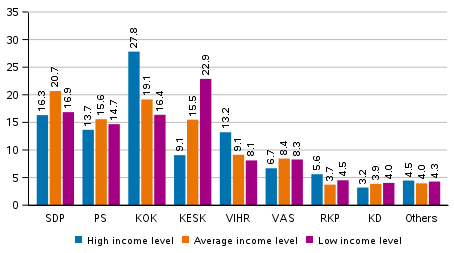
Change in the support for the parties in the Municipal elections 2021 by areas specified by the income level, %
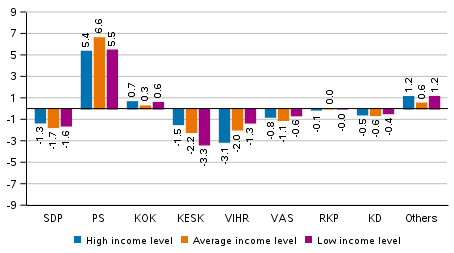
The support profile of the Coalition Party, the Green League and the Left Alliance is similar in areas divided by the industrial structure, support for all was highest in those areas where service industries employed the most. This is particularly emphasised in the case of the Greens. As expected, support for the Centre Party was highest in agricultural-dominated areas, for the Finns Party in both agricultural and industrial areas. The Social Democratic Party received support especially from industrial areas. The Centre Party lost its support in relative terms most in agricultural areas, while the Green League lost most support in service areas. Both the Social Democratic Party and the Left Alliance lost support in agricultural and industrial areas, whereas the growth in support for the Finns Party focused to some extent on industrial and agricultural areas.
Support for the parties in the Municipal elections 2021 by areas specified by economic structure, %
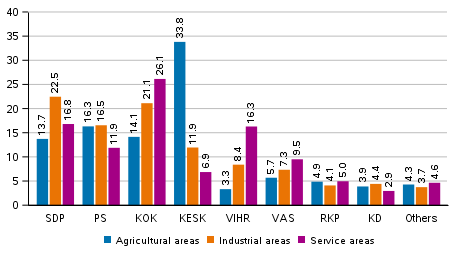
Change in the support for the parties in the Municipal elections 2021 by areas specified by economic structure, %
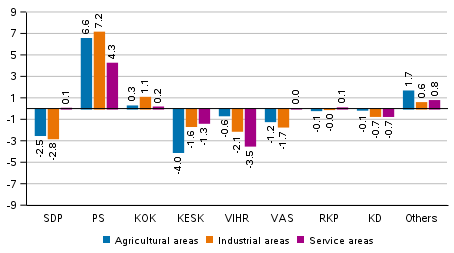
Statistics Finland's election result services
Before the elections, Statistics Finland released a review on 4 June 2021 on the background of municipal election candidates analysing the candidates' sex distribution, age, origin, education, employment, income level and family status in comparison to persons entitled to vote. The review will be updated on 24 June 2021 with background data on the elected councillors. The review on voting turnover will be published on 13 July 2021, which will examine voting turnout by means of unit-level background factors, such as age, sex, education and income.
Source: Municipal Elections 2021, confirmed election result, Statistics Finland
Inquiries: Sami Fredriksson 029 551 2696, Jaana Asikainen 029 551 3506, vaalit@stat.fi
Head of Department in charge: Hannele Orjala
Publication in pdf-format (2.0 MB)
- Tables
-
Tables in databases
Pick the data you need into tables, view the data as graphs, or download the data for your use.
Appendix tables
- Figures
-
- Appendix figure 1. Map: Party with highest number of votes by municipality in Municipal elections 2021, whole country (22.6.2021)
- Appendix figure 2. Map: Voting percentage by municipality in Municipal elections 2021, whole country (22.6.2021)
- Appendix figure 3. Map: Support for the National Coalition Party by municipality in Municipal elections 2021, whole country (22.6.2021)
- Appendix figure 4. Map: Support for the Social Democratic Party by municipality in Municipal elections 2021, whole country (22.6.2021)
- Appendix figure 5. Map: Support for the Centre Party by municipality in Municipal elections 2021, whole country (22.6.2021)
- Appendix figure 6. Map: Support for the Finns Party by municipality in Municipal elections 2021, whole country (22.6.2021)
- Appendix figure 7. Map: Support for the Green League by municipality in Municipal elections 2021, whole country (22.6.2021)
- Appendix figure 8. Map: Support for the Left Alliance by municipality in Municipal elections 2021, whole country (22.6.2021)
- Appendix figure 9. Map: Support for the Swedish People's Party by municipality in Municipal elections 2021, whole country (22.6.2021)
- Appendix figure 10. Map: Support for the Christian Democrats by municipality in Municipal elections 2021, whole country (22.6.2021)
- Appendix figure 11. Map: Support for Constituency associations by municipality in Municipal elections 2021, whole country (22.6.2021)
- Quality descriptions
-
- Municipal elections, quality description (22.6.2021)
Updated 22.06.2021
Official Statistics of Finland (OSF):
Municipal elections [e-publication].
ISSN=2323-1114. preliminary data 2021. Helsinki: Statistics Finland [referred: 25.12.2025].
Access method: http://stat.fi/til/kvaa/2021/03/kvaa_2021_03_2021-06-22_tie_001_en.html

